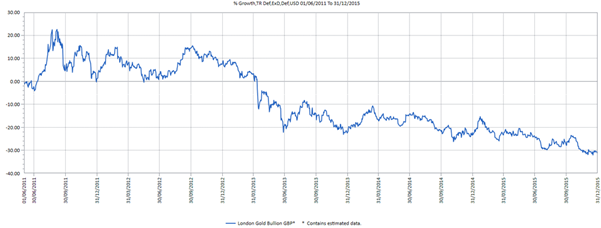What's driving the Gold price?
The spot gold price broke through the $4,000-an-ounce mark for the first time ever on Wednesday 8 October 2025. Jason Hollands, explores what’s fuelling the surge, why a number of investors are flocking to gold, how to buy it, and the risks you should be aware of.
The value of investments can fall as well as rise and that you may not get back the amount you originally invested.
Nothing in these briefings is intended to constitute advice or a recommendation and you should not take any investment decision based on their content.
Any opinions expressed may change or have already changed.
Written by Jason Hollands
Published on 22 Oct 20257 minute read

Introduction
This latest leg upwards for gold to a new all-time high above $4,000 an ounce has been driven by concerns over the shutdown of the US Federal government - but as you can see from the chart below, the precious metal has enjoyed an impressive rally since the latter part of 2022. Startlingly, the price of gold has doubled in less than two years.

Past performance is not a guide to future performance.
Source: Lipper
A brief history on gold
Gold has long appealed as a store of wealth in many diverse societies due to its scarcity, the fact it doesn’t perish and an almost universal perception of it being valuable across many different cultures. For centuries it effectively backed the global financial system, but even after fiat currencies replaced gold-backed systems, central banks continued to hold gold reserves as a hedge against inflation and currency risk.
US Treasuries in the second half of the 20th century in some ways replaced gold as a guaranteed store of wealth thanks to their backing by the world’s strongest economy and most constitutionally robust government. In the last couple of decades gold’s appeal to investors has been augmented by financial crises, geopolitical uncertainty and bouts of market volatility, when investors typically flock to gold as a ‘safe haven’.
Historically gold is typically seen as less attractive if other “safe haven” assets are generating high interest or income. Gold is a zero-yielding asset: bars of the precious metal are fundamentally unproductive assets – they just sit there in a vault and do nothing.
Traditionally, when yields on US Treasuries rise this has often been a headwind for gold because institutional investors would rather receive an attractive yield on ultra-safe US Treasuries, and this typically saps demand for the gleaming metal.
In this sense, the current bull market in gold is highly unusual because it has taken place against the backdrop of sharply rising US Treasury yields and tightening monetary policy. The 10-year US Treasury yield has climbed from 1.51% at the start of 2022 to 4.1%, as at 9/10/2025 (1).
Why has gold become popular recently?
The key driver behind the bull market that began in 2022 has been central banks voraciously purchasing gold to diversify their reserves away from US Treasuries and shift away from the US Dollar. The origins of this lay with Russia’s invasion of Ukraine in early 2022, which triggered extensive sanctions and the freezing of Russian financial assets across the globe.
Numerous other emerging market countries, including China, clearly took note and have subsequently stepped-up purchases of gold because it can be stored in physical vaults, making it harder to seize than financial securities such as bonds. There is no reason to believe that such buying won’t continue, as it is estimated that gold currently represents around 15 – 20% of central bank reserves globally, but historically this has been as high as 50% in some cases (2).
More recently, surging gold prices also reflect bubbling uncertainties over the macroeconomic outlook, with signs of growth slowing in the US, tariffs expected to stoke inflation and worries about ballooning deficits. Whether you look at the political turmoil in France, the Federal shutdown in the US or even the fragile state of the UK public finances, uncertainty is all around. Concerns about an AI bubble in the equity markets is also another likely factor driving some investors to purchase gold as they batten down the hatches.
However, retail investors thinking of piling into gold now - as with any asset whose price has rocketed so dramatically – must be careful as a change in sentiment could send this volatile asset into reverse.
What are the risks of holding gold?
Owning physical gold in your home clearly carries the risk of theft if you haven’t taken out adequate insurance and don’t have strong security in place, but another risk is your ability to sell swiftly.
But the main risk is that while gold is talked of as a “safe haven” and “port in a storm”, it can still be very volatile. While it can be a very useful diversifier in an investment portfolio, it shouldn’t be regarded as low risk, and as with all investments, there are risks and you could still make losses. Funds invested in physical gold can suffer from changes in sentiment and gold prices are also susceptible to buying and selling by large investors such as central banks.
Gold has seen some long losing streaks in the past. As the chart below shows, gold saw a prolonged bear market between June 2011 and the end of 2015, sliding -30%.

Past performance is not a guide to future performance.
Source: Lipper
Three ways to invest in gold
If you think gold has a place in your portfolio, there are some example investment ideas below. This is not a recommendation to invest in these funds. All investors should carry out their own research and get financial advice before investing if unsure. You should make sure any new investment forms part of a diversified portfolio. For more details on each fund, including risks and charges, use the links to their factsheets and Key Investor Information below.
1. Physical gold tracker fund
From an investment perspective, the most straightforward way to own gold in a portfolio is through an exchange traded commodity (ETC) – which are similar to exchange traded funds (ETFs).
ETCs track the gold price and are traded on the stock market.
The advantage of using an ETC is that you can trade it swiftly and these can also be held within tax efficient accounts such as ISAs, SIPPs and Junior ISAs – unlike a piece of jewellery or a chunk of bullion.
ETCs can be high risk and complex and may not be suitable for all investors. You should make sure you understand all the risks involved before investing.
Example physical gold ETCs
Annual cumulative return
Performance data is rolling one year performance, net of charges.
| 01/10/2024 – 30/09/2025 | 01/10/2023 – 30/09/2024 | 01/10/2022 – 30/09/2023 | 01/10/2021 – 30/09/2022 | 01/10/2020 – 30/09/2021 | |
| Invesco Physical Gold ETC | 45.18% | 29.05% | 1.14% | 14.98% | -11.42% |
|
WisdomTree Physical Gold |
44.64% | 28.77% | 0.82% | 14.68% | -11.62% |
Past performance is not a guide to future returns.
Source: Morningstar, up to 30/09/2025
Invesco Physical Gold ETC
WisdomTree Physical Gold
2. Gold mining companies or a specialist gold or mining fund
An indirect option to achieve exposure to gold has been through investing in the shares of gold mining companies or a specialist gold or mining fund. However, these can be incredibly volatile and are not for the faint hearted. Gold equities had lagged the rally in gold prices for several years until recently but have surged in recent months, playing catch up.
Example mining funds
Annual cumulative return
Performance data is rolling one year performance, net of charges.
| 01/10/2024 – 30/09/2025 | 01/10/2023 – 30/09/2024 | 01/10/2022 – 30/09/2023 | 01/10/2021 – 30/09/2022 | 01/10/2020 – 30/09/2021 | |
| BlackRock Gold & General | 88.51% | 38.39% | 5.43% | -8.31% | -27.45% |
|
VanEck Gold Miners UCITS ETF |
93.55% | 36.07% | 2.02% | 0.63% | -27.16% |
Past performance is not a guide to future returns.
Source: Morningstar, up to 30/09/2025
BlackRock Gold & General
VanEck Gold Miners UCITS ETF
3. Physical gold
Of course, you can also purchase actual physical gold items that broadly fall into either bars, coins or jewellery. The thing to bear in mind here are the costs of storage, security and insurance – especially if you are going to keep such items in your home - and the process of selling won’t be as swift as hitting a button on an app or website. Nor can you hold these in your ISA or a typical pension.
One reason some people may be attracted to buying gold coins produced by the Royal Mint, is that they have the status of a legal tender currency, and any gains made are exempt from Capital Gains Tax. This could be an option for those wanting to invest in gold outside of tax efficient ISAs and Pensions. However, gold coins are priced at a premium to bullion costs because of the craftsmanship involved and then you need to bear in mind any storage or insurance costs if you choose to hold them at home. The Royal Mint does offer storage facilities.
What is a sensible exposure to gold?
If you’re an existing Bestinvest client investing in one of our ready-made portfolios, chances are you already have some exposure to gold. We hold approximately 4.5% in gold across most of our ready-made portfolios. However, the amount of exposure to gold you are willing to have in your portfolio will depend on your attitude to risk and your investing goals
The primary reason we hold gold is to provide a de facto form of “portfolio insurance” that can perform well in times of crisis and uncertainty. It also provides some inflation-proofing qualities too and provides diversification beyond equities and bonds.
Sources
(1) Bloomberg
(2) Evelyn Partners Investment Strategy team
Get insights and events via email
Receive the latest updates straight to your inbox.
You may also like…




Investing



